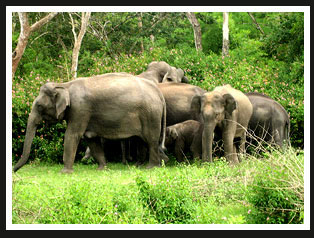Elephant in India
The Indian Elephant is a smaller than its African cousin. The average height of an Indian Elephant is around 8-9 ft with female being slightly smaller in size. The difference between an Indian Elephant and an African one other than the height is its ears, The African Elephant has very big ears (looks like map of Africa) as compared to the Indian Elephant, its forehead is smaller then the Indian Elephant, it has three nails on the hindfoot as compared to Indian's four, the African elephant's trunk has two lips at the end and the Indian Elephant has only one.

Elephant in India
In Indian Elephant only the male has tusks whereas in the African one both male and female has the tusks. Some of the male Indian Elephant are without tusks and are called "Makhnas". These elephants are very big in size and are prone to charging.
In India, The elephants are found in the lower ranges of the Himalayas, in the Western Ghats right on till the forest of Kerala, Tamil Nadu, Karnataka, Orissa, West Bengal, Assam.
Elephants like Bamboo and are generally found in areas having plenty of Bamboo forests. They prefer tall forested areas for the shade and move quite a distance in search of food. In the dry season they tend to keep themselves to the denser parts of the forests but sometimes in search of food they raid the cultivation fields near the forests and the plantations causing extensive damage to the crops. Elephants are always seen in herds comprising of an extended family of cousins and aunts and is always lead by the most experienced and old female. Large males or the bulls are never part of the herds but are always seen following them at a distance.
Found In
Manas, Cobett and Periyar National Park, Bandipur National Park, Nagarhole National Park in India.
Habitat
Indian Elephants live in different habitat in open grassland, marshes and savannas. They can also be found in jungles, water sources and mountainous regions.
Diet
The Indian Elephants mostly feeds on a wide variety of grasses. They are also dependent upon cultivated crops, bark, root, twigs, fruits and leaves. They are one among the herbivorous animals. An adult elephant can consume up to 300 pounds of food in a single day.
Behavior
The groups (herds) of elephants are matriarchal i.e., a female elephant leads the herd. Males remain isolated and rarely form groups. They usually join the herd only when the mating season approaches. The members of a herd make use of a number of gestures and sounds while communicating with each other. Their sense of commitment towards the other members of the group is very strong. A female elephant protects her young one very fiercely. In her absence, this responsibility comes in the hands of the other females of the herd.
Conservation status
The population of the Indian Elephants lies somewhere between 38,000 and 51,000. They have been continuously haunted by the people for the food, for ivory and for the domestic stock. They have suffered the great habitat loss due to the deforestation and agriculture.
Lifespan
Lifespan of the Indian Elephants is about 70 years.


